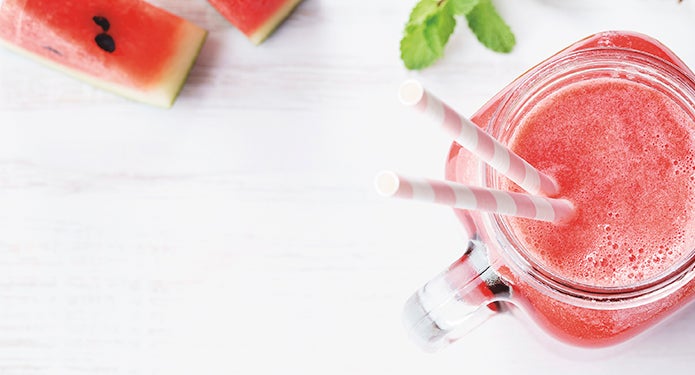Craft sodas and creative blended beverages stand out as ways to enhance the guest experience while creating menu differentiation.
The foodservice industry looks to beverages as a way to build better margins. With sales of traditional carbonated sodas in rapid decline, and on-premises alcohol sales showing only modest growth potential, craft sodas and creative blended beverages stand out as ways to enhance the guest experience while creating menu differentiation.
The natural/craft beverage segment—defined as featuring real sugar, containing 100% natural ingredients and manufactured in small batches and/or labeled as “handcrafted”—is growing in popularity. According to Technomic Inc.’s 2016 Canadian Beverage Consumer Trend Report: Quenching Canada’s Thirst:
- 49% of consumers say they’re more likely to purchase beverages that are handcrafted or house made.
- 34% of consumers—especially Gen Z (50%) and millennials (43%) desire greater beverage variety at full-service restaurants.
- 23% of consumers are willing to pay more for beverages made with 100% fruit juice.
Here are three ways restaurants can take the lead in this consumer-driven trend.
Pop go the craft pops
Housemade soft drinks are simple and relatively inexpensive. Use a concentrate of flavoured syrup as the base and blend with carbonated water or seltzer, pre-mixed in a tap dispenser or carbonated with a CO2 canister.
Draw inspiration from traditional soda fountains and make liberal use of aromatics and phosphates, blending artisan craftsmanship with retro flavour combinations. To create a contemporary cherry phosphate, for example, use tart cherry syrup and phosphoric acid powder. Whip up a complex take on a Greyhound cocktail by combining grapefruit, pineapple gomme[cq] syrup, juniper and bergamot. The gomme syrup will serve as an emulsifier that produces a silky mouthfeel that adds depth to the finished beverage.
Another way to create distinctive mouthfeel is to purée—but not strain—housemade syrup bases in order to concentrate the flavour. Finished beverages using this technique will be opaque rather than clear. “The presentation is striking,” says Gordon Food Service Corporate Consulting Chef Gerry Ludwig, CEC, “and the color and flavour are quite intense.” Toppings such as a thick, creamy layer of foam and a fresh-herb garnish further enhance the look and value perception of such beverages.
Herbs and vegetables also offer opportunities to menu distinctive beverages. Tasty examples include: lemon verbena-maple soda and cucumber-celery soda with lime and celery bitters.
“Bitters and tinctures,” Ludwig notes, “are a great way to create different layers of flavour.” Steep herbs, spices or fruits in grain alcohol for up to a month, strain and then place the infusion in an atomizer. Such proprietary formulations are easy to make, are completely stable and add an attractive aromatic quality when spritzed onto finished beverages.
Opportuni-tea
Matcha, the powdered hand-picked first growth of green-tea leaves, is a premium product with explosive growth in the beverage-trend segment.
“The primary attraction, for many,” Ludwig says, “is the significant amount of antioxidants, caffeine and L-theanine, a naturally occurring amino acid. This combination supposedly provides a slow release of caffeine for sustained energy and mental clarity.”
While traditionally served as a ceremonial cup of tea whisked vigorously with hot water, the real opportunity for matcha in commercial foodservice is with barista-style beverages such as lattes, cortados and hot chocolate. The extremely fine powder can be challenging to blend using a traditional milk steamer, but there are workarounds. Streamline the process by making a pre-prepared paste that can be quickly steamed with milk (regular, almond or soy) and sweetener for efficient service.
Light and refreshing cold beverages, such as matcha lemonades, juices and iced teas are gaining in popularity. Blend matcha and/or regular iced tea with fresh-squeezed juices such as watermelon, cucumber and fuji-apple-ginger.
Smoothie moves
As consumers become as mindful about wholesome beverages as they are about food, smoothies are poised to grow stronger as a sales-building opportunity. According to the Technomic reported cited earlier in this story, 38% of consumers want restaurants to offer healthier beverage options and 60% say they’re more likely to purchase all-natural beverages.
“Consumers have made it clear that they look for beverages that are natural and free from artificial ingredients,” says Kelly Weikel, Technomic’s Director of Consumer Insights. “Emphasizing these aspects along with functional benefits like digestive support and stress relief can help appeal to today’s consumers and also increase cheque averages.”
Take this popular beverage to the next level with unique, on-trend flavour combinations, creative garnishes and a focus on health.
As consumers have become more concerned about sugar intake, smoothies incorporating vegetables such as kale, spinach, avocado and celery are growing in popularity. Offer customization options—such as adding maca or matcha powders—that allow customers to create their own blend. Use açai berries—a superfood rich in antioxidants and high in pectin content—to craft especially thick, creamy smoothies without dairy products. Choose frozen açai purée, Ludwig advises, for superior texture and flavour.
The bottom line? Revamping your beverage program has never looked sweeter.










